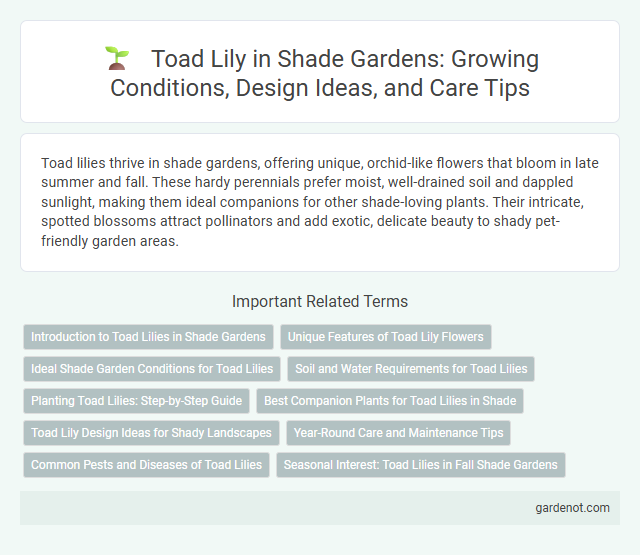Toad lilies thrive in shade gardens, offering unique, orchid-like flowers that bloom in late summer and fall. These hardy perennials prefer moist, well-drained soil and dappled sunlight, making them ideal companions for other shade-loving plants. Their intricate, spotted blossoms attract pollinators and add exotic, delicate beauty to shady pet-friendly garden areas.
Introduction to Toad Lilies in Shade Gardens
Toad lilies (Tricyrtis spp.) thrive in shade gardens, offering unique, orchid-like flowers that bloom in late summer to fall. These perennials prefer moist, well-drained soil and partial to full shade, making them ideal for woodland or shaded border areas. Their intricate spotted petals and delicate blossoms enhance garden diversity and attract pollinators in low-light environments.
Unique Features of Toad Lily Flowers
Toad lily flowers (Tricyrtis) showcase striking orchid-like blossoms with intricate spotted and speckled petals, often in shades of purple, white, and lavender, perfect for enhancing shade gardens. Their unique curved stamens and star-shaped blooms bloom primarily in late summer to fall, providing vibrant color when many other shade plants fade. These flowers thrive in moist, well-drained soil and attract pollinators like bees and butterflies, adding ecological value to shaded landscapes.
Ideal Shade Garden Conditions for Toad Lilies
Toad lilies thrive in moist, well-drained soil with rich organic matter and prefer partial to full shade, making them ideal for shaded garden areas under trees or along shaded borders. They require consistently cool temperatures and protection from harsh midday sun to prevent leaf scorch and ensure vibrant blooms. Incorporating mulch helps retain soil moisture and maintains the cool environment essential for healthy toad lily growth in a shade garden.
Soil and Water Requirements for Toad Lilies
Toad lilies thrive in rich, well-draining soil with consistent moisture to support their delicate roots and promote vibrant blooms. They prefer slightly acidic to neutral pH levels, ideally between 6.0 and 7.0, ensuring optimal nutrient uptake. Regular watering is essential, especially during dry periods, to maintain the moist environment these shade-loving perennials require.
Planting Toad Lilies: Step-by-Step Guide
Plant Toad lilies in well-drained, rich organic soil with partial to full shade exposure to mimic their natural woodland habitat. Space each Toad lily rhizome 12 to 18 inches apart, planting them 1 to 2 inches deep to ensure optimal root development and moisture retention. Water thoroughly after planting and maintain consistent soil moisture, avoiding waterlogged conditions to promote healthy growth and abundant late-summer blooms.
Best Companion Plants for Toad Lilies in Shade
Hostas, ferns, and astilbes are ideal companion plants for toad lilies in shade gardens due to their similar moisture and light requirements. These shade-loving perennials enhance the toad lily's exotic blooms while creating a textured, layered plant design. Choosing companions that thrive in partial to full shade ensures a harmonious and thriving garden bed.
Toad Lily Design Ideas for Shady Landscapes
Toad lily (Tricyrtis) thrives in shade gardens, making it an ideal choice for adding unique texture and late-season blooms to shady landscapes. Its intricate, freckled flowers complement hostas and ferns, creating a layered, natural woodland effect that enhances visual interest during autumn. Incorporating toad lilies in mixed shade borders or alongside moss-covered stones amplifies their exotic appeal and supports biodiversity in low-light garden areas.
Year-Round Care and Maintenance Tips
Toad lilies (Tricyrtis spp.) thrive in shaded garden areas with consistently moist, well-drained soil enriched with organic matter. Regular watering is essential during dry spells to maintain soil moisture, while applying a layer of mulch helps retain hydration and suppress weeds. Prune dead or damaged stems in late winter to promote healthy growth and ensure vibrant blooms throughout the fall season.
Common Pests and Diseases of Toad Lilies
Toad lilies (Tricyrtis spp.) are susceptible to slugs and snails, which can cause significant damage by feeding on their delicate foliage. Powdery mildew often affects these shade-loving perennials, leading to white, powdery fungal growth on leaves that impairs photosynthesis. Root rot may occur in poorly drained soils, emphasizing the need for well-drained, moist environments to maintain healthy toad lily plants.
Seasonal Interest: Toad Lilies in Fall Shade Gardens
Toad lilies (Tricyrtis) provide striking seasonal interest in fall shade gardens with their unique, orchid-like blooms that emerge from late summer to early autumn. Their intricate spotted flowers brighten shaded woodland areas when many other plants have finished blooming, adding vibrant purple, white, and lavender hues. The foliage also offers texture and color variation as it transitions into autumn, enhancing the garden's overall visual appeal during the fall months.
Toad lily Infographic

 gardenot.com
gardenot.com